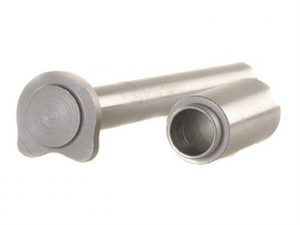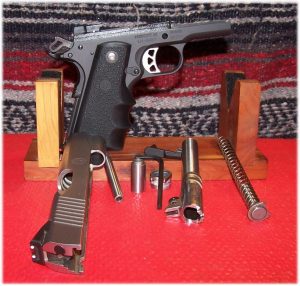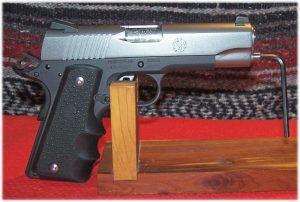
Ed Brown 2-Piece Full Length Recoil Spring Guide Rod with Recoil Spring Plug 1911 Commander Stainless Steel
The Rock Island 1911 “Tactical” FS
My Rock Island 1911 Tactical FS came equipped with a FLGR. A Ruger SR1911 Lightweight Commander that I own does not incorporate a FLGR. Both pistols shoot well and are “combat” accurate to the point that they shoot pretty much point-of-aim at “combat” distance and most errant shots are a product of my not following established shooting standards and methodologies.
I am pretty confident that, if I do my part, a projectile fired from either the RIA or the SR would impact a target at some point distant from my usual 10-yard shooting distance. At twenty-five yards, I have no problem with either of these pistols, although I cannot tell you where, specifically, the round will impact the target. If a round impacts the target not where I think it should, I usually blame it on me or the curvature of the earth at twenty-five yards or some other reason; such as, the projectile was a victim of the turbulence caused by cartridge velocity shock wave that just occurred from the shooter’s pistol in the next lane.
My first experiment with FLGRs was with the RIA 1911 Tactical FS. I decided, for whatever reason, to swap out the FLGR with a standard guide rod and plug from a standard RIA “Government” model. Take-down of the 1911 without a FLGR is quite simple, but that was not the reason for the exchange; I really wanted to see if a FLGR made a difference in accuracy.
Usually, I can obtain a pretty good group with the RIA 1911 Tactical FS at ten yards; I used this distance as a foundation for the comparison. I did not want to bench rest the pistol, as this would not be a fair comparison, because the majority of my handgun shooting is from a modified Weaver stance and flash sight picture. I simply needed to shoot the way that I always shoot for, what I felt, would be an honest comparison. I was surprised at the results. I had made a point of shooting the same ammunition that I shot prior to exchanging the FLGR for a standard GR. There was a noticeable difference in the horizontal axis. In other words, while the impacts in the vertical plane were about the same as I normally shoot, there was a definite increase in the width of the shot group. Now, I am not talking about inches and inches of difference, but if I threw out the few “out of bounds” impacts, the group was substantially bigger than my normal groups – when I do my part. Now, I was really curious.
It just so happened that I had enough foresight to bring the FLGR that was in the pistol, and a swap was quickly made. I had shot 3 magazines of 5 rounds with the standard GR; it was time to shoot the same amount with the FLGR. A fresh silhouette target was put in place and driven downrange to the same 10-yard marker. Another 3 magazines of 5 rounds told the story. The end of the story comes later in the article.
The Ruger SR1911 “Lightweight” Commander

Part are Parts.
The FLGR chosen was an Ed Brown 2-Piece Full Length Recoil Spring Guide Rod with Recoil Spring Plug 1911 Commander Stainless Steel.
- Color: Silver
- Finish: Stainless
- Material: Stainless Steel
- Compatible with 1911 Commander

The Ed Brown 2-Piece FLGR Requires a Hex-Head tool (provided with FLGR).
The Ruger SR1911 “Lightweight” Commander, in stock form and compared to the Rock Island 1911 Tactical FS, is not as accurate. This is not a surprise to me; however, due to the “Commander” barrel length of 4.25-inches and the lighter weight of the pistol, which means that it requires more grip control to tame the recoil from even modest loads. However, the sights on the Ruger are much better than those on the RIA. In the long run, and in my mind, everything balances out.
The installation was done in less than a minute. The FLGR was a perfect fit. In short, it was a perfect drop – in conversion.
Three magazines of five rounds each were used at the same 10-yard distance as was used with the RIA. Once again there was a distinct difference in the resulting group. As with the RIA, there was a fist size hole in the target as close to my point of aim as I could muster. This was a definite improvement over previous groups with this pistol. My confidence in the Ruger SR1911 “Lightweight” Commander was increasing, although I carry the Ruger as my EDC most of the time and rotate it with the RIA whenever I feel the need.
Closing it out

Ed Brown FLGR Fully Installed.
Note that these two pistols were not fired from a bench-rested position, as I needed to shoot them as I normally would and observe the results. The results were positive and pleasing. The results also solidified in my mind that enhanced accuracy was possible through the use of FLGRs – at least in the two 1911s tried in this experiment.
I was confident enough in them, at least at this point, to order another Ed Brown unit to try in the Ruger SR1911 “Lightweight” Commander in 9mm, which could use some help in the accuracy department, although it is an excellent example of a 9mm 1911-based pistol.
![]()

